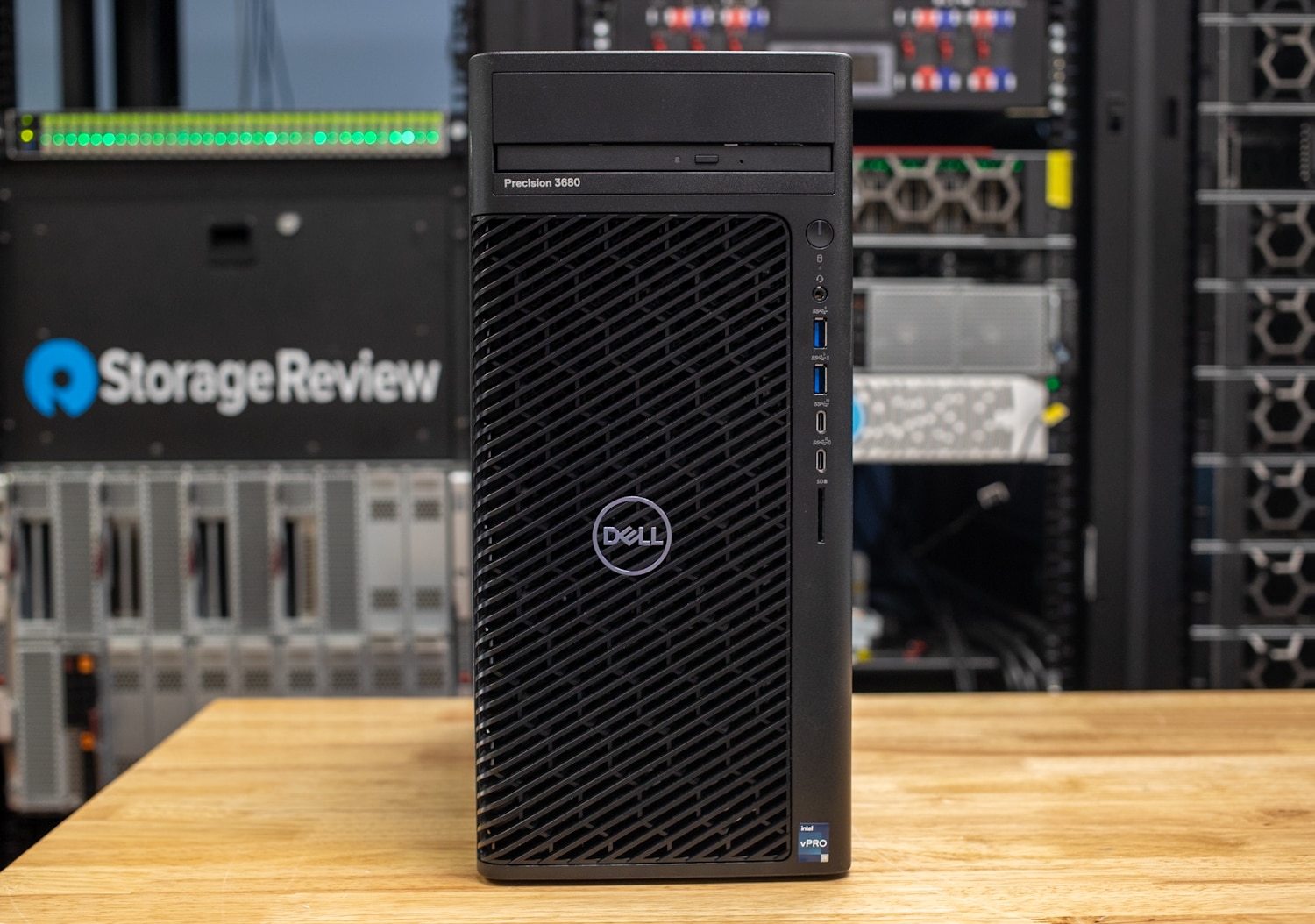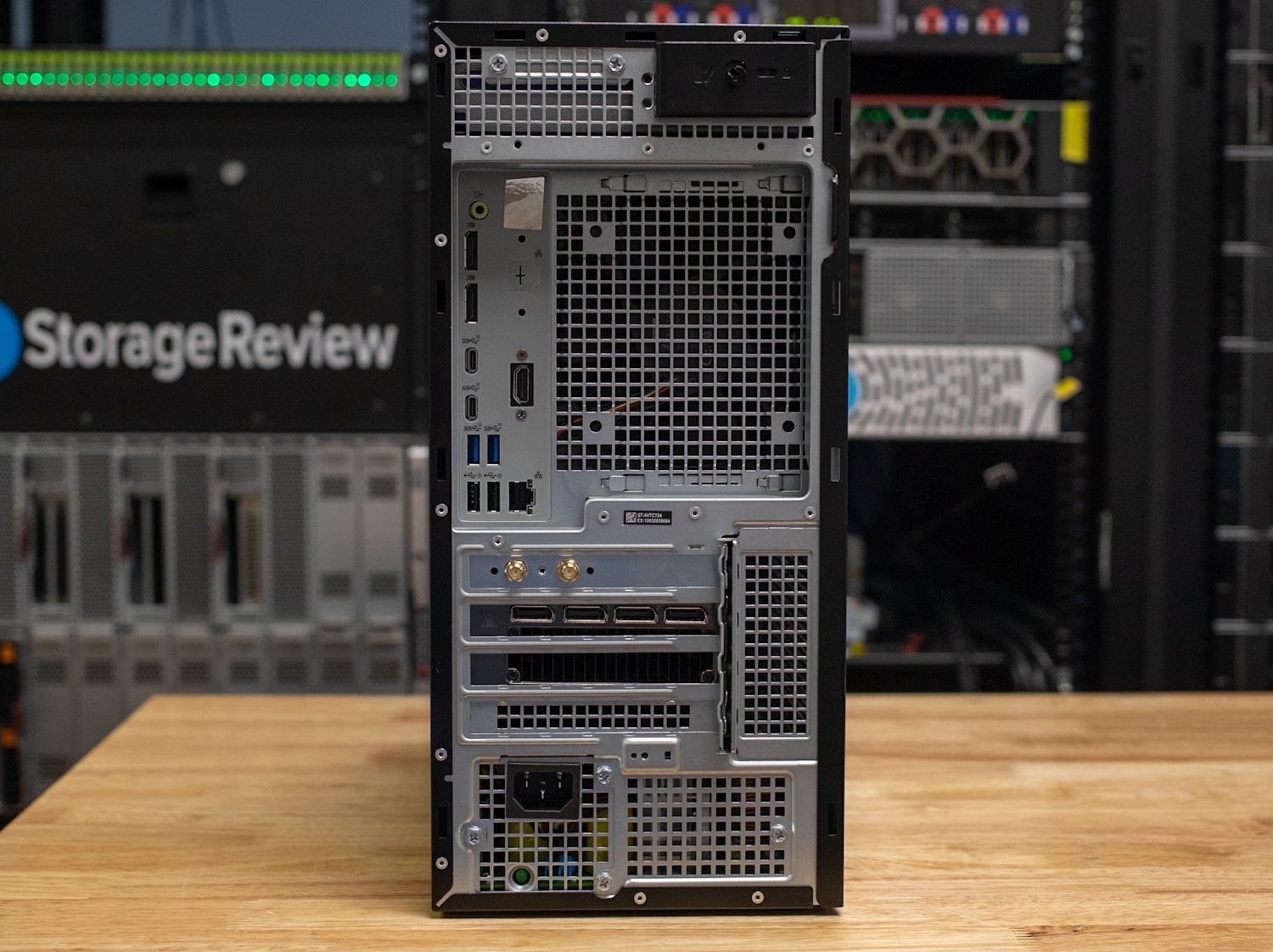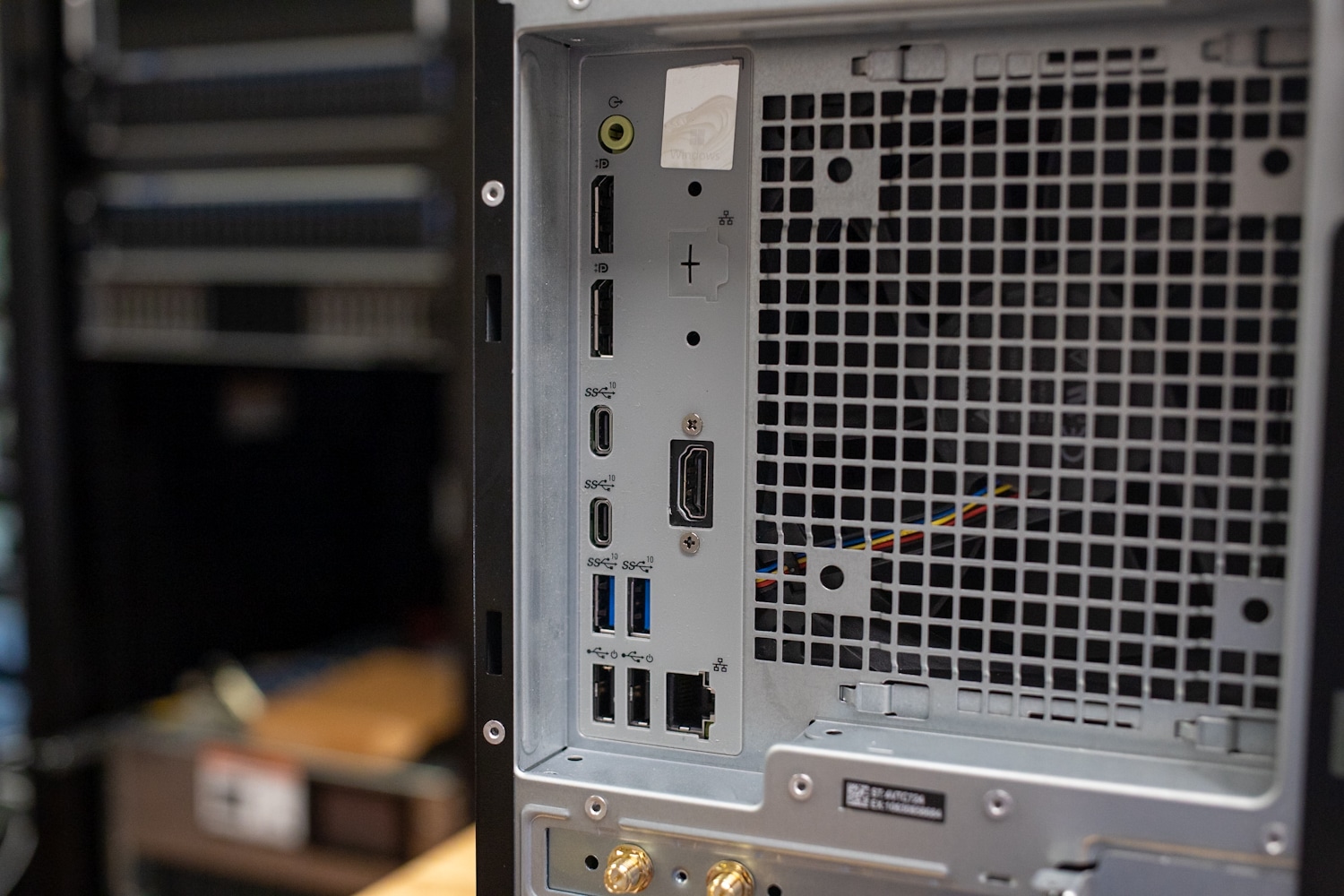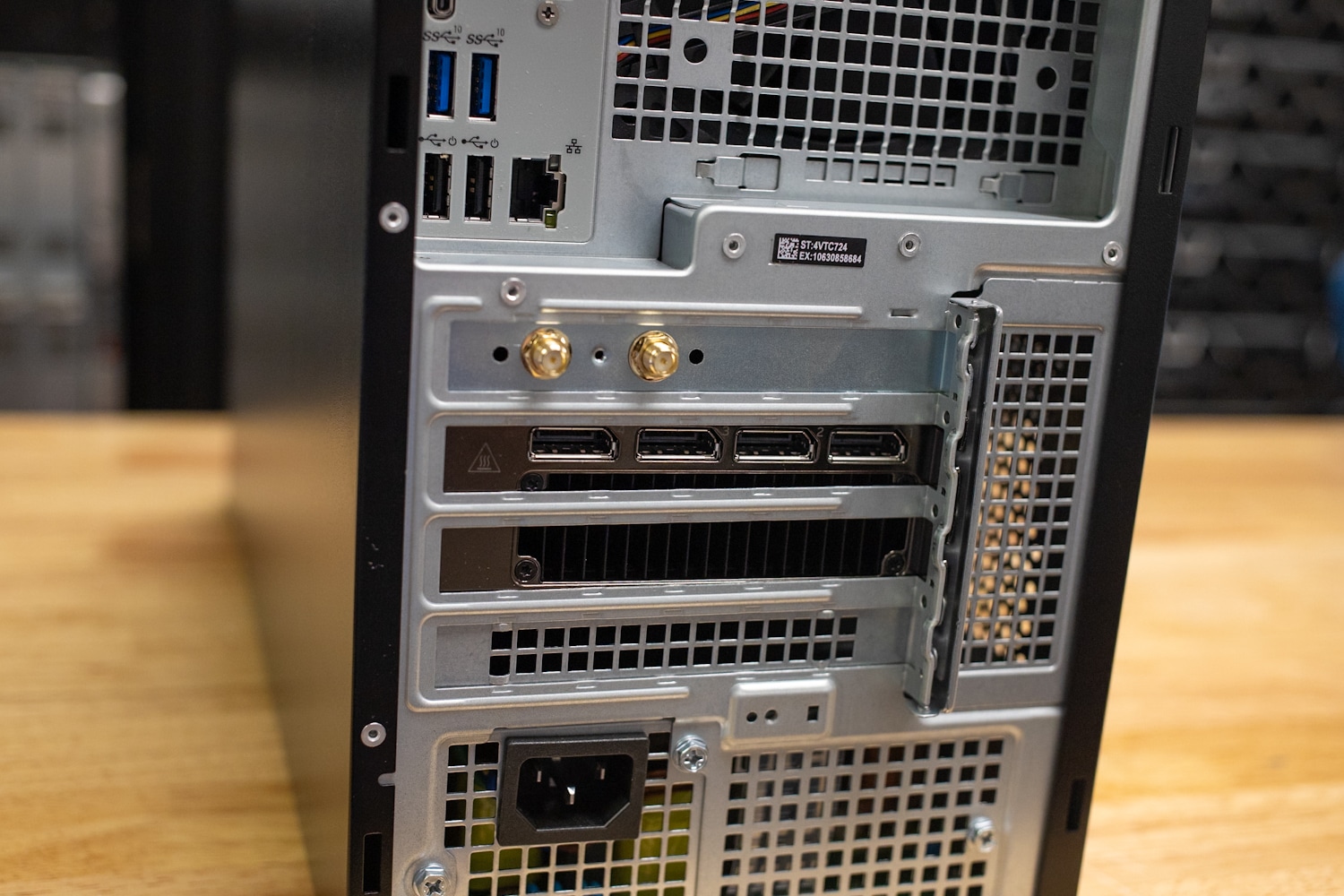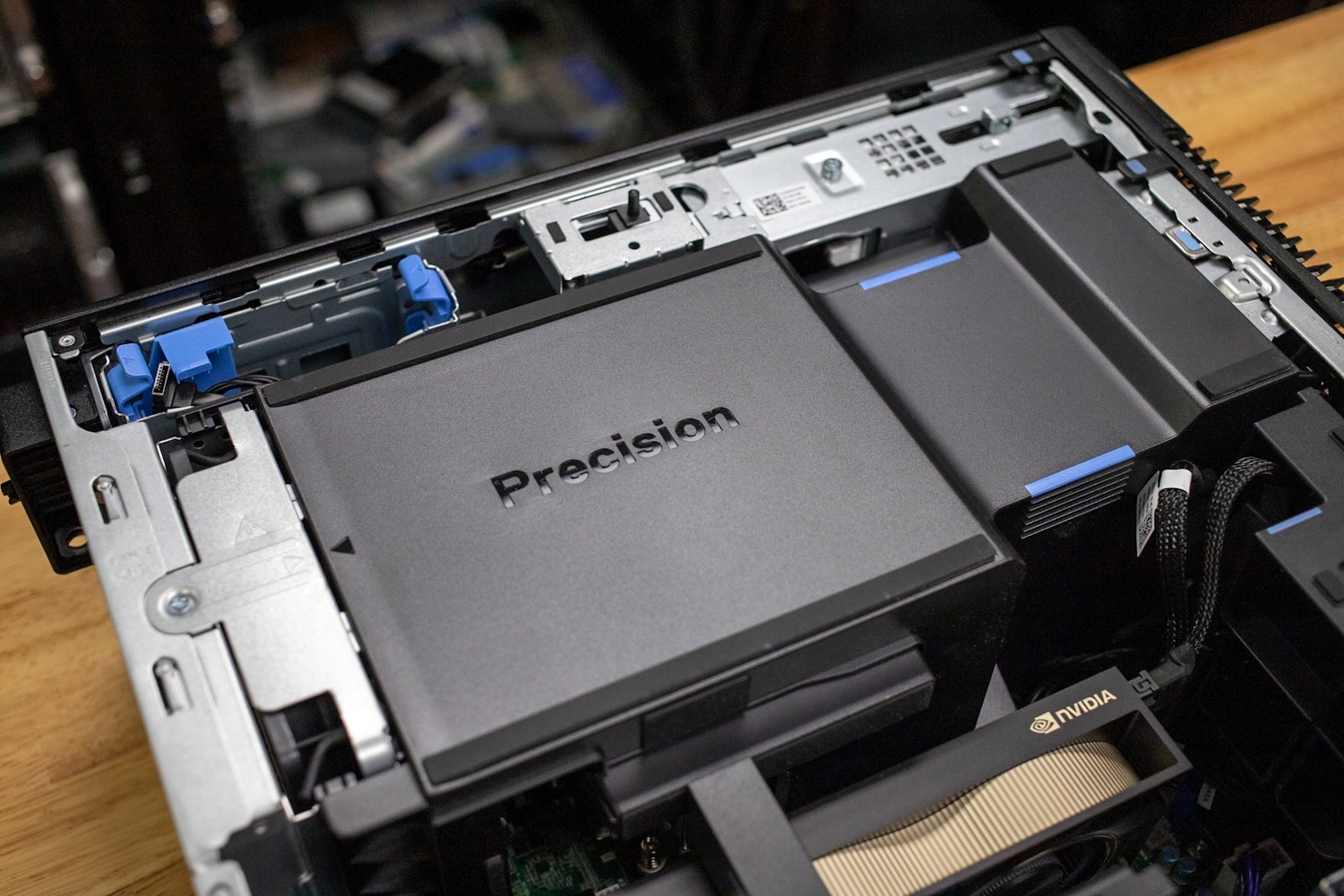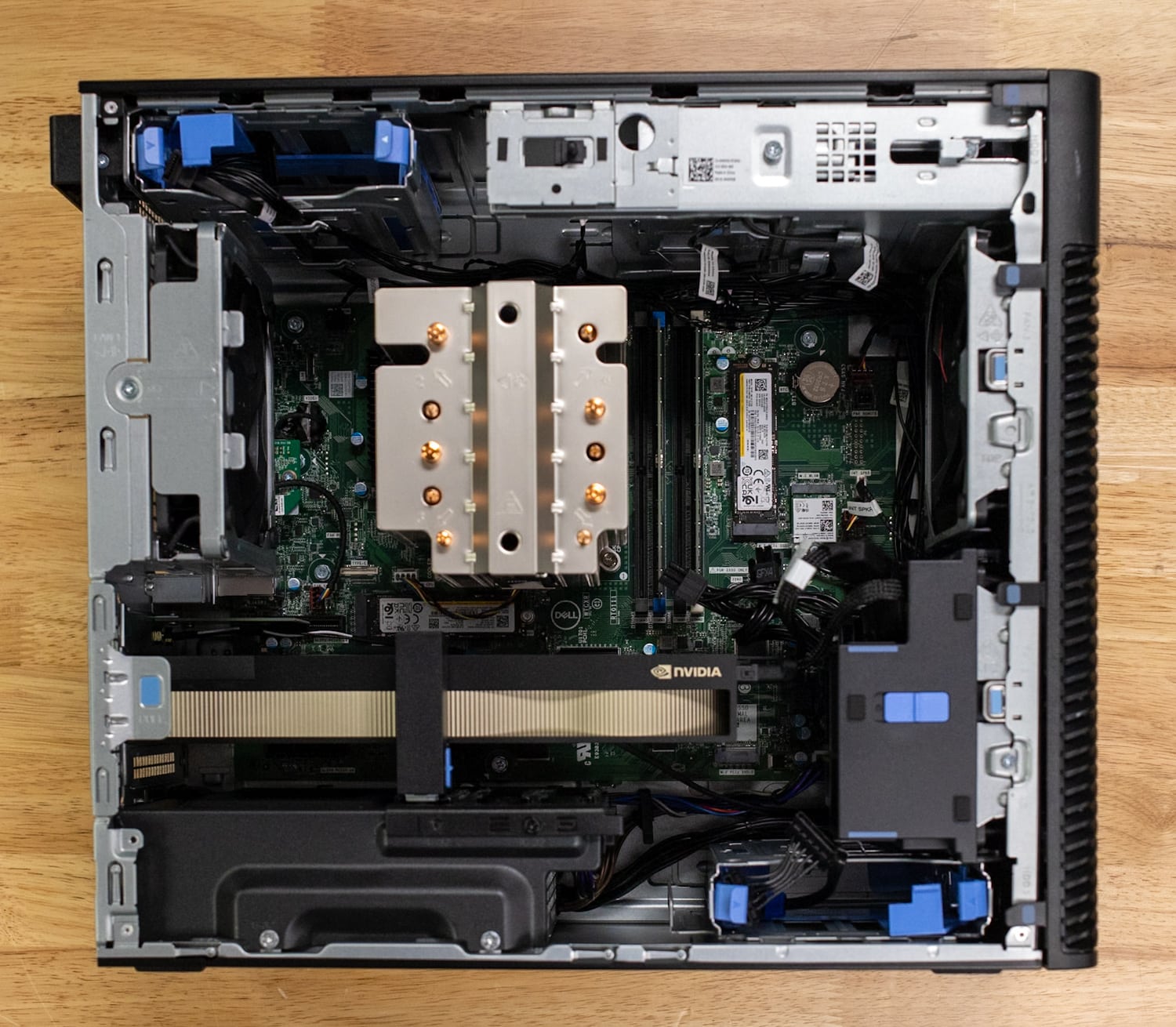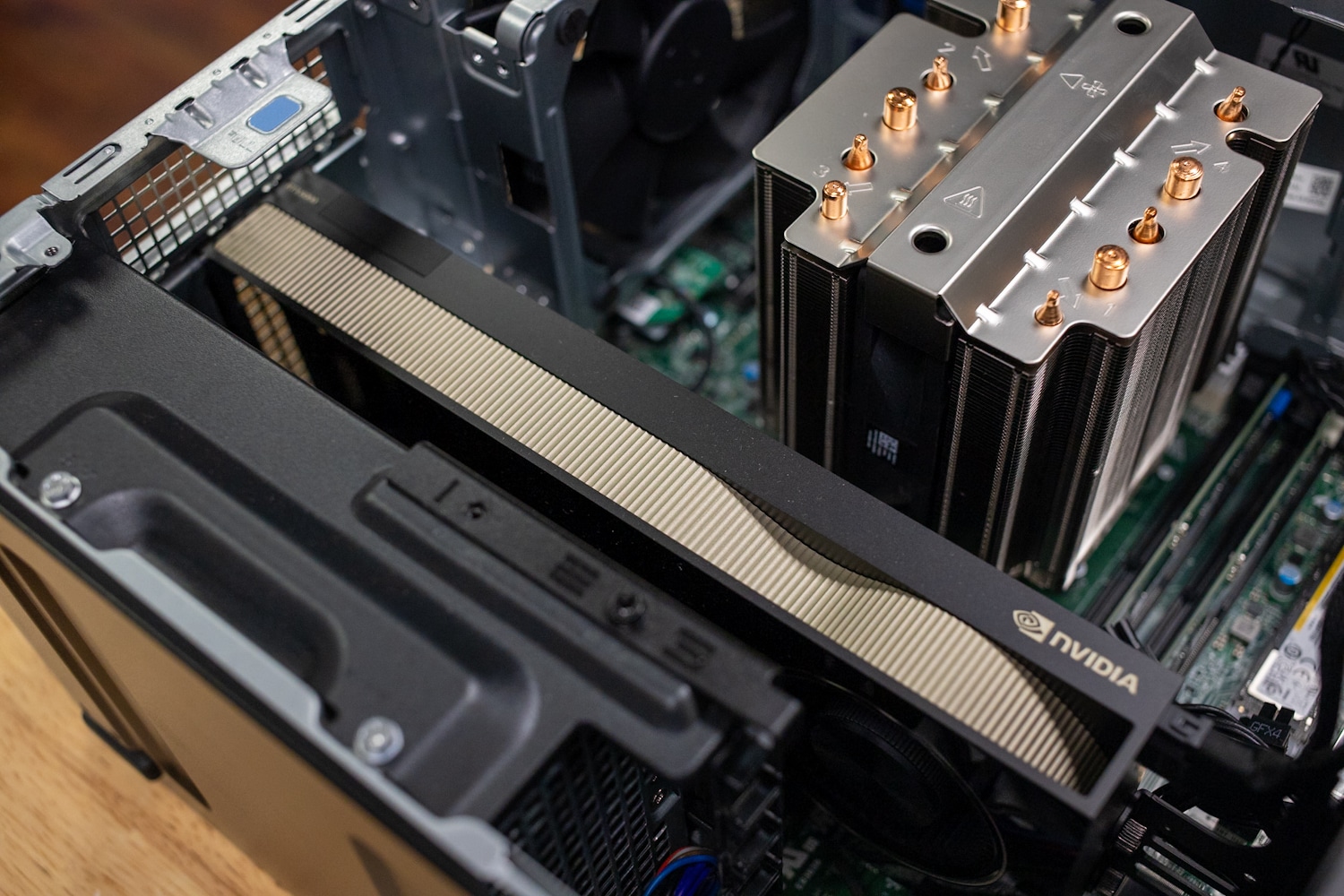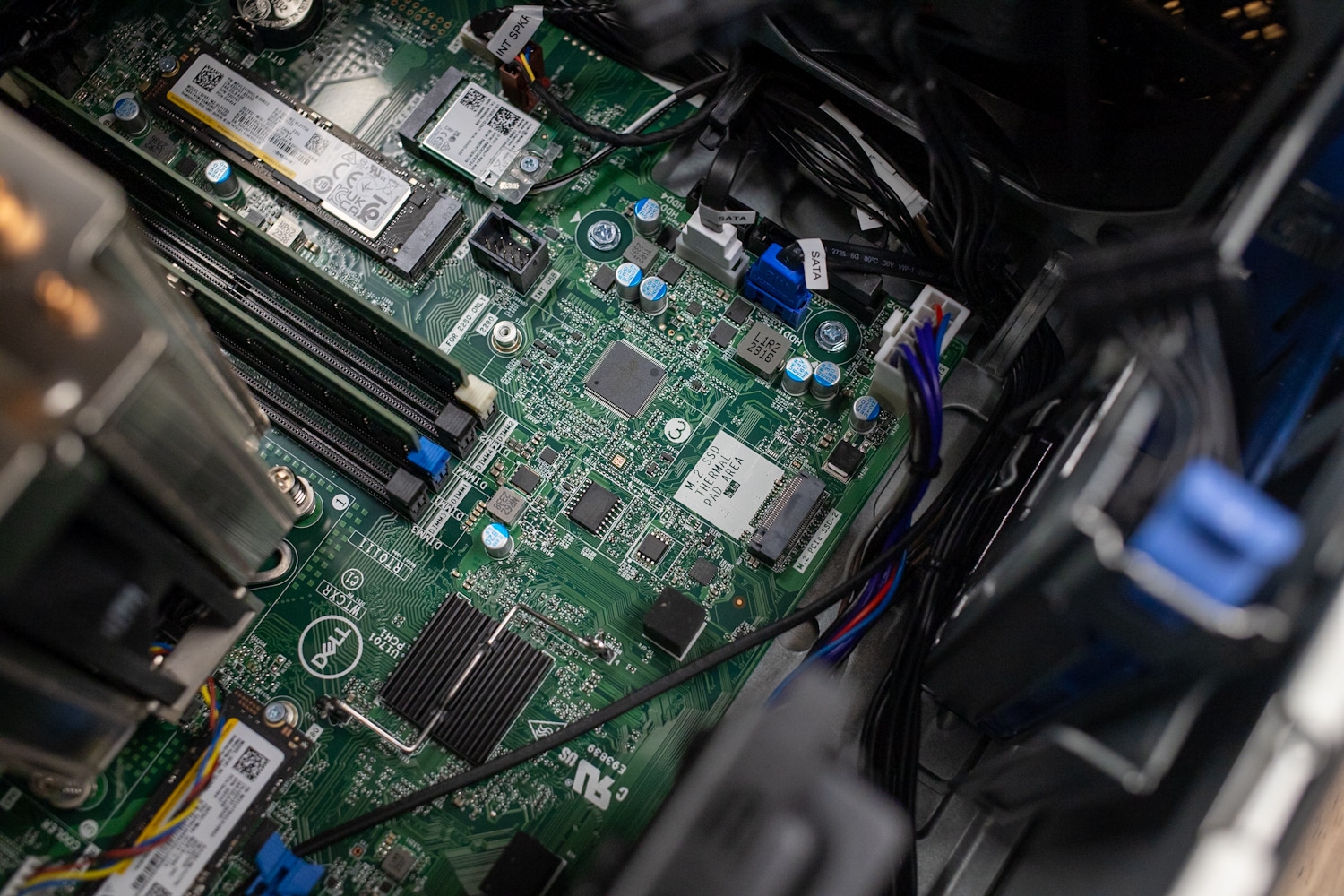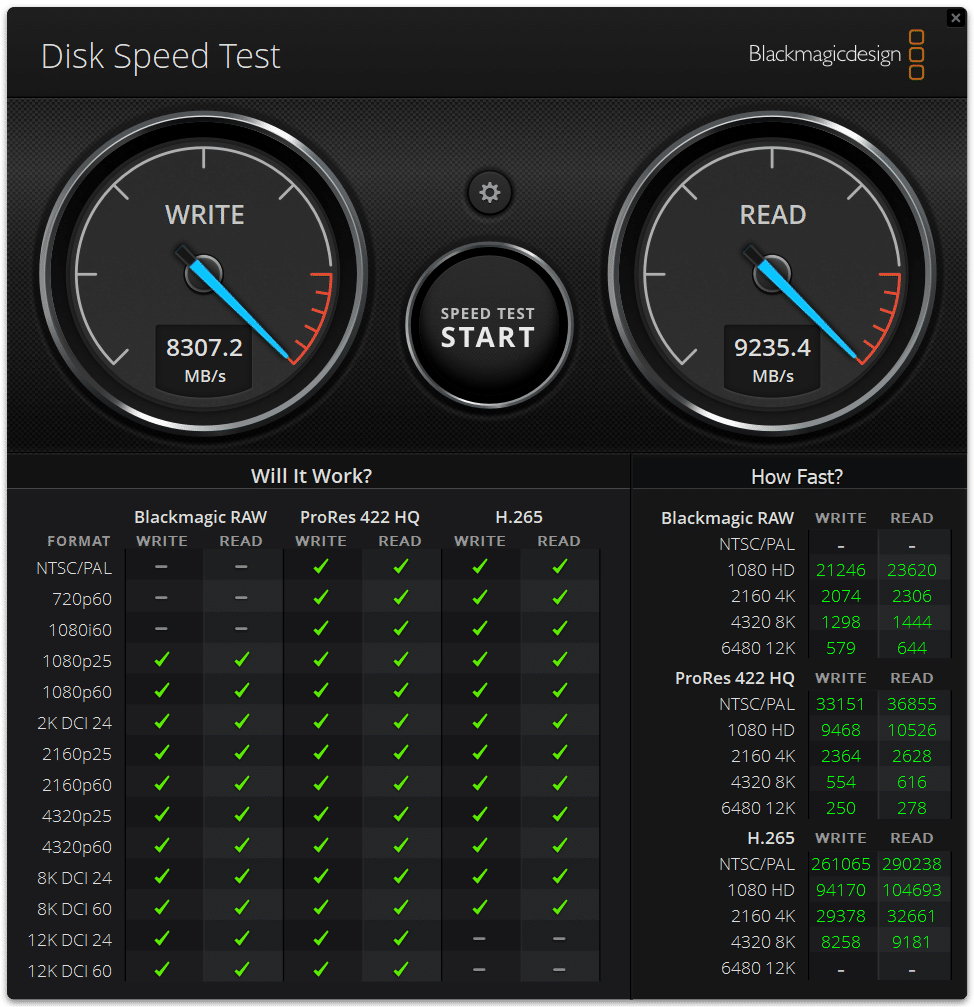The Dell Precision 3680 is an affordable mid-tower workstation with 14th-gen Intel Core CPUs, offering excellent value.
Not every workstation user needs a server-class CPU. Dell’s Precision 3680 pairs high-end consumer CPUs with an NVIDIA RTX 6000 Ada Generation.
Dell Precision 3680 Specifications
The Precision 3680 is an entry-level tower workstation. Hardware-wise, it’s a far cry from the Xeon-equipped Precision 5860 or the Precision 7875 featuring the 96-core AMD Threadripper Pro, but it’s also far less expensive, starting at just $1,029. Its Intel 14th Gen Core processors support 128GB of ECC memory and Intel vPro remote management. The top CPU is the 24-core/32-thread Core i9-14900K.
This Precision supports one 450W GPU for graphics and although for those that don’t have such high demands you can configure it with an entry NVIDIA T400. The Precision 3680 also includes many ISV certifications.
The Precision 3680’s competition comes from the HP Z2 tower workstation and the Lenovo ThinkStation P3 tower workstation, which also uses Intel Core CPUs.
This tower’s full specifications are as follows:
| Processor | 14th Gen Intel Core i3 through Core i9, up to 125W K-class |
| Operating System | Windows 11 or Ubuntu Linux 22.05 LTS |
| Memory | 4x DDR5 DIMM slots, 128GB max. |
| Storage | 3x M.2 2280 slots and 3x 3.5-inch drives Front-accessible 3.5-inch drive available with specific configurations |
| Graphics |
|
| Ports | Front:
Rear:
|
| Slots | Front:
Rear:
|
| Dimensions |
|
| Wireless |
|
| Power |
|
| Hardware Security |
|
Dell Precision 3680 Build and Design
The Precision 3680 uses the same design language as Dell’s higher-end workstations. The plastic front panel is almost entirely perforated for airflow. Our model has a laptop-style, tray-load DVD writer at the top. Ports down the right edge include a 3.5mm universal audio jack, two USB 3.2 Gen 1 Type-A (lowermost with PowerShare), one USB 3.2 Gen 2 Type-C, one USB 3.2 Gen 2×2 Type-C with PowerShare, and an SD card slot. The power button and a drive activity light are also here.
Our unit doesn’t have the optional 3.5-inch lockable front drive caddy, which would go in the bay at the top. At 14.7 x 6.8 x 16.5 inches (HWD), the Precision 3680 is typically sized for a mid-tower. Most of the tower is rolled steel for sturdy build quality.
The back of the tower also has many perforations for front-to-back airflow.
Rear ports include 3.5mm audio-out, DisplayPort 1.4a video output, two USB 3.2 Gen 2 Type-C ports (one with PowerShare), two USB 3.2 Type-A, two USB 2.0, and one 2.5Gbps Ethernet. An optional port can also be fitted; options include VGA, HDMI 2.0, DisplayPort 1.4, and USB 3.2 Gen 2 Type-C. There is also a cable lock slot back here.
The two gold jacks visible below are for the wireless card. Our unit has the optional Intel AX211 add-in card, which supports Wi-Fi 6E and Bluetooth 5.3.
Internal full-height expansion slots include one Gen5 x16, one Gen3 x4, and Gen4 x4. Our review unit’s NVIDIA RTX 6000 Ada Generation has the expected quad DisplayPort outputs.
The plastic tab on the back of the tower must be pulled for internal access through the left panel. We’re immediately greeted with a massive airflow guide that covers the CPU air cooler and the RAM.
The guide is easily removed using the tool-less blue pinch points. The massive CPU air cooler has many copper heat pipes. The “advanced” cooler seen here is a required upgrade with the Intel K-series CPUs. Notice there are four DIMM slots next to the CPU. Higher-end workstations will have at least eight DIMM slots. The Precision 3680’s maximum memory configuration is 4x 32GB (128GB total). Both ECC and non-ECC memory are supported.
The motherboard has three M.2 2280 slots for storage, and in our configuration, there is room for two 3.5-inch drives, one at the top left and the other at the bottom right.
The bottom-mounted power supply in our model is rated for 1,000 watts; 300- and 500-watt models are also available. The power supply appears to be proprietary but does carry an 80 PLUS Platinum certification. Notice how the NVIDIA graphics card has a support bracket at the center and is secured to the front of the tower via a plate. Like almost everything else in this tower, the graphics card can be removed without tools.
Below are the two M.2 2280 SSDs and the M.2 2230 wireless card.
The Precision 3680’s interior is well-designed and easy to service. However, the Core i9-14900 K processor can be quite loud under load and challenging to air-cool effectively. It would be great to have a liquid cooling option at some point.
Dell Precision 3680 Performance
Our review has the following specifications:
- Intel Core i9-14900K (24-core/32-thread, up to 6.0GHz), air-cooled
- Windows 11 Pro
- 64GB DDR5 non-ECC RAM (2x 32GB)
- NVIDIA RTX 6000 Ada Generation (48GB)
- 2x 1TB Gen4 SSDs in RAID 0
- Intel AX211 Wi-Fi 6E + Bluetooth 5.3
- 8X DVD+/-RW
- Three-year warranty
- Starting price: $1,029
- Price as tested: $9,087
Dell continually reminds us that just one percent of its workstations are sold on Dell.com; most are sold through its channel partners, where you’ll likely get better pricing anyway if you’re buying in bulk.
Our configuration is head and shoulders faster than the base model, which has a Core i3-14100, integrated graphics, 8GB of RAM, and a 256GB SSD, but it’s hard to imagine this model being ordered like that. (We don’t consider it a workstation unless it has dedicated graphics.) The most expensive upgrade on our review model is the NVIDIA RTX 6000 Ada Generation GPU, which adds a shocking $6,340. Most GPU options are workstation-grade (NVIDIA RTX or AMD Radeon Pro), though Dell also offers an NVIDIA GeForce RTX-class consumer GPU.
Other notable configuration options include three storage drives and ECC memory. (Intel discontinued its entry-level Xeon processors some time ago, which were clones of Core-class CPUs with ECC memory support. Nowadays, many Core CPUs support ECC.)
Let’s get started on the performance testing. For comparison, we’re using the Dell Precision 5860 equipped with a 24-core/48-thread Intel Xeon w7-2495X and a previous-generation RTX A6000. This configuration should provide insight into how an entry-level and a high-end workstation compare, though the Precision 3680 should be much faster in GPU-bound testing.
SPECworkstation 3
SPECworkstation3 specializes in benchmarks designed for testing all critical aspects of workstation performance; it uses over 30 workloads to test CPU, graphics, I/O, and memory bandwidth. The workloads fall into broader categories such as Media and Entertainment, Financial Services, Product Development, Energy, Life Sciences, and General Operations. We will list the broad-category results for each instead of the individual workloads. The results are an average of all the individual workloads in each category.
Many of these tests are GPU-bound and don’t take advantage of high CPU core counts, so the Precision 3680 dominated overall except in Product Development, which it didn’t complete.
| SPECworkstation 3 (Higher is better) | Dell Precision 3680 | Dell Precision 5860 |
| Media and Entertainment | 6.21 | 5.55 |
| Product Development | N/A | 6.1 |
| Life Sciences | 6.97 | 6.08 |
| Financial Services | 7 | 6.4 |
| Energy | N/A | 6.59 |
| General Operations | 4.06 | 2.97 |
| GPU Compute | 10.64 | 7.55 |
SPECviewperf 2020
Our first test is SPECviewperf 2020, the worldwide standard for measuring graphics performance of professional applications under the OpenGL and Direct X application programming interfaces. The viewsets (or benchmarks) represent graphics content and behavior from actual applications without having to install the applications themselves. The newest version of this benchmark went through major updates late last year, including new viewsets taken from traces of the latest versions of 3ds Max, Catia, Maya, and Solidworks applications. In addition, they added support within all viewsets for both 2K and 4K resolution displays.
This is a dream test for the Precision 3680, where its Core i9 and RTX 6000 combo dominated and recorded excellent numbers.
| SPECviewperf2020 Viewsets (Higher is better) | Dell Precision 3680 | Dell Precision 5860 |
| 3dsmax-07 | 221.03 | 140.87 |
| Catia-06 | 134.49 | 89.1 |
| Creo-03 | 212.66 | 125.11 |
| Energy-03 | 88.23 | 42.93 |
| Maya-06 | 576.59 | 327.89 |
| Medical-03 | 132.02 | 35.13 |
| Snx-04 | N/A | 480.1 |
| Sw-05 | 302.35 | 171.32 |
Luxmark
Another 3D benchmark we will look at is LuxMark, an OpenCL GPU benchmarking utility. The Precision was just under Lenovo’s beefier RTX A5000. (We don’t have results for the HP in this test.)
This mostly GPU-focused test shows how much more powerful the Precision 3680’s RTX 6000 Ada Generation is than the Precision 5860’s RTX A6000.
| Luxmark (Higher is better) | Dell Precision 3680 | Dell Precision 5860 |
| Hallbench | 33,744 | 21,716 |
| Food | 15,614 | 8,047 |
Blender OptiX
Blender is an open-source 3D modeling application. This benchmark was run using the Blender Benchmark utility. The score is samples per minute, with higher being better.
This is another test where the Precision 3680 dominated with its faster GPU.
| Blender OptiX (Samples per minute, Higher is better) | Dell Precision 3680 | Dell Precision 5860 |
| Monster | 5,805.6 | 2,804.91 |
| Junkshop | 2,649.8 | 1,777.03 |
| Classroom | 2,800.76 | 1,511.06 |
ESRI
Next up is the Environmental Systems Research Institute (Esri) benchmark. Esri is a supplier of Geographic Information System (GIS) software. Esri’s Performance Team designed their PerfTool add-in scripts to launch the ArcGIS Pro automatically. This application uses a “ZoomToBookmarks” function to browse various predefined bookmarks and create a log file with all the key data points required to predict the user experience. The script automatically loops the bookmarks three times to account for caching (memory and disk cache). In other words, this benchmark simulates heavy graphical use that one might see through Esri’s ArcGIS Pro software.
The tests consist of three primary datasets. Two are 3-D city views of Philadelphia, PA, and Montreal, QC. These city views contain textured 3-D multipatch buildings draped on a terrain model and draped aerial images. The third dataset is a 2-D map view of the Portland, OR region. This data contains detailed information for roads, land use parcels, parks and schools, rivers, lakes, and hill-shaded terrain.
As in previous tests, the Precision 5860’s RTX A6000 can’t match the newer RTX 6000 Ada Generation in the Precision 3680.
| ESRI (Higher is better) | Dell Precision 3680 | Dell Precision 5860 | |
| Montreal | |||
| Average FPS | 850.45 | 571.87 | |
| Minimum FPS | 431.52 | 269.05 | |
| Philly | |||
| Average FPS | 649.72 | 455.11 | |
| Minimum FPS | 366.42 | 266.14 | |
| Portland | |||
| Average FPS | 3,938.42 | 758.12 | |
| Minimum FPS | 2,129.10 | 1,280.95 | |
OctaneBench
Next, we look at OctaneBench, a benchmarking utility for OctaneRender, another 3D renderer with RTX support similar to V-Ray.
| OctaneBench (Score, higher is better) | Kernel | Dell Precision 3680 | Dell Precision 5860 |
| Interior | Info channels | 43.65 | 18.15 |
| Interior | Direct lighting | 130.17 | 66.92 |
| Interior | Path tracing | 163.73 | 86.89 |
| Idea | Info channels | 26.19 | 11.35 |
| Idea | Direct lighting | 102.69 | 52.73 |
| Idea | Path tracing | 122.81 | 64.84 |
| ATV | Info channels | 68.40 | 28.53 |
| ATV | Direct lighting | 128.81 | 74.63 |
| ATV | Path tracing | 163.42 | 93.79 |
| Box | Info channels | 35.16 | 15.56 |
| Box | Direct lighting | 121.93 | 66.64 |
| Box | Path tracing | 133.41 | 75.42 |
Blackmagic RAW Speed Test
We have also started running Blackmagic’s RAW speed test, which tests video playback. This is one test where the Precision 5860 wasn’t caught napping. Its more robust CPU core count probably helped it clinch the lead, and not by a small margin.
| Blackmagic RAW Speed Test (Higher is better) | Dell Precision 3680 | Dell Precision 5860 |
| 8K CPU | 108 fps | 127 fps |
| 8K CUDA | 119 fps | 178 fps |
7-Zip Compression
The built-in memory benchmark in the popular 7-Zip utility also revealed the advantages of having a full-fledged workstation like the Precision 5860. It was the overall better performer thanks to its high core count and greater memory bandwidth.
| 7-Zip Compression Benchmark (Higher is better) | Dell Precision 3680 | Dell Precision 5860 | |
| Current CPU Usage | 1,080% | 2,505% | |
| Current Rating/Usage | 11.763 GIPS | 6.679 GIPS | |
| Current Rating | 127.011 GIPS | 167.332 GIPS | |
| Resulting CPU Usage | 1,153% | 2,516% | |
| Resulting Rating/Usage | 11.099 GIPS | 6.676 GIPS | |
| Resulting Rating | 127.542 GIPS | 167.962 GIPS | |
| Decompressing | |||
| Current CPU Usage | 3,021% | 4,725% | |
| Current Rating/Usage | 6.521 GIPS | 3.879 GIPS | |
| Current Rating | 197.036 GIPS | 183.259 GIPS | |
| Resulting CPU Usage | 3,022% | 4,724% | |
| Resulting Rating/Usage | 6.523 GIPS | 3.874 GIPS | |
| Resulting Rating | 197.094 GIPS | 183.014 GIPS | |
| Total Rating | |||
| Total CPU Usage | 2,087% | 3,260% | |
| Total Rating/Usage | 8.811 GIPS | 5.275 GIPS | |
| Total Rating | 162.318 GIPS | 175.488 GIPS | |
Blackmagic Disk Speed Test
To calculate disk speed, we ran the popular Blackmagic Disk Speed Test against the system’s primary storage drive. The Precision 3680’s RAID0 array of dual Gen4 drives produced impressive results.
UL Procyon AI Inference
UL’s Procyon estimates a workstation’s performance for professional apps. We ran the test on each system, once on the CPU and once on the GPU with TensorRT. The Precision 3680’s RTX 6000 Ada Generation GPU proved an absolute monster. Its Core i9-14900K also proved faster than the Precision’s Xeon in several tests, but it wasn’t anywhere close in several, so again, there are limitations to using a consumer-grade CPU. (That said, you’d likely be buying something like the Precision 5860 for this type of work anyway.)
| UL Procyon Average Inference Times (Lower is better) | Dell Precision 3680 (Core i9-14900K) | Dell Precision 5860 (Xeon w7-2495X) | Dell Precision 3680 (RTX 6000 Ada) | Dell Precision 5860 (RTX A6000) |
| MobileNet V3 | 0.89 ms | 1.84 ms | 0.38 ms | 0.60 ms |
| ResNet 50 | 7.13 ms | 6.73 ms | 0.98 ms | 1.50 ms |
| Inception V4 | 20.79 ms | 18.58 ms | 3.00 ms | 4.62 ms |
| DeepLab V3 | 24.05 ms | 24.63 ms | 2.59 ms | 3.94 ms |
| YOLO V3 | 50.92 ms | 30.53 ms | 2.40 ms | 4.49 ms |
| Real-ESRGAN | 2,413.15 ms | 1,570.19 ms | 79.17 ms | 127.51 ms |
| Overall Score | 184 | N/A | 1,749 | N/A |
y-cruncher
y-cruncher is a multi-threaded and scalable program that can compute Pi and other mathematical constants to trillions of digits. Since its launch in 2009, it has become a popular benchmarking and stress-testing application for overclockers and hardware enthusiasts. The extra cores on the Precision 5860’s Xeon helped it win by a large margin here.
| y-cruncher (Total computation time in seconds; lower is better) | Dell Precision 3680 | Dell Precision 5860 |
| 1 billion digits | 22.246 | 16.009 |
| 2.5 billion | 62.443 | N/A |
| 5 billion | 138.698 | N/A |
| 10 billion | 304.706 | 201.526 |
Geekbench 6
Geekbench 6 is a cross-platform benchmark that measures overall system performance. You can find comparisons to any system you want in the Geekbench Browser. This test favors high CPU clock speeds rather than core count, so the Precision 3680 was able to dominate with its Core i9.
| Geekbench 6 (Higher is better) | Dell Precision 3680 | Dell Precision 5860 |
| CPU Single-Core | 3,059 | 2,302 |
| CPU Multi-Core | 19,216 | 17,320 |
| GPU | 326,382 | 191,730 |
Cinebench R23
This benchmark uses all CPU cores and threads to generate an overall score. We only have numbers for the Precision 3680.
| Cinebench R23 (Higher is better) | Dell Precision 3680 |
| Multi-Core | 35,108 |
| Single-Core | 2,266 |
Cinebench 2024
We also started running the latest Cinebench test. We only have numbers for the Precision 3680.
| Cinebench R23 (Higher is better) | Dell Precision 3680 |
| Multi-Core | 1,950 |
| Single-Core | 131 |
| GPU | 31,939 |
3DMark
We also ran the consumer 3DMark suite on the Precision 3680. We only have numbers for the Precision 3680.
| 3DMark Testing (Higher is better) | Dell Precision 3680 |
| Fire Strike Extreme | 35,953 |
| Fire Strike Ultra | 21,236 |
| Port Royal | 19,362 |
| Speed Way | 8,288 |
| Time Spy Extreme | 14,440 |
| Time Spy | 28,338 |
Conclusion
Dell’s Precision 3680 is an affordable mid-tower workstation that can be an excellent value. Its 14th-generation Intel Core processors are far less expensive than Xeon chips found in full-fledged workstations, but they can still pack a real punch where CPU clock speed is essential, especially in the Core i9-14900K guise we reviewed. (It did create quite a bit of noise when we stressed it, though.)
We also noted the Precision 3680’s easy serviceability, flexible configurations, availability with ECC memory, and even a front-accessible 3.5-inch drive bay as an option. Provided you don’t need more than one high-end GPU and 128GB of RAM, the Precision 3680 is a worthy alternative to a high-end workstation.
Dell Precision 3680 Configurator
Engage with StorageReview
Newsletter | YouTube | Podcast iTunes/Spotify | Instagram | Twitter | TikTok | RSS Feed

